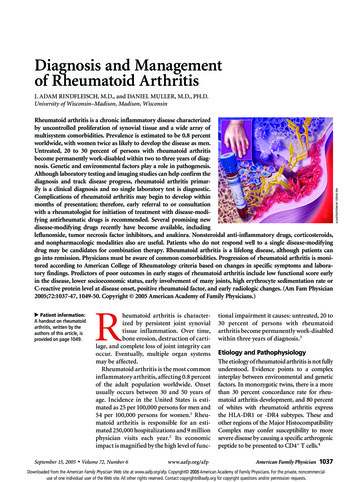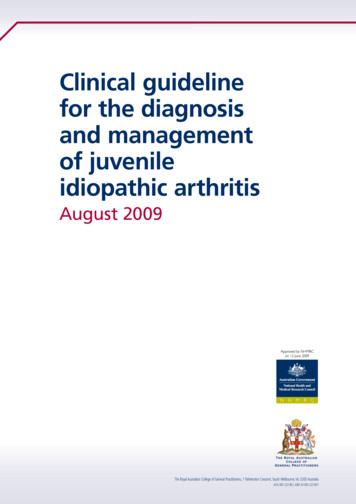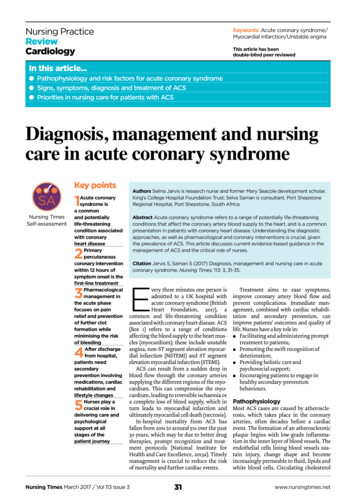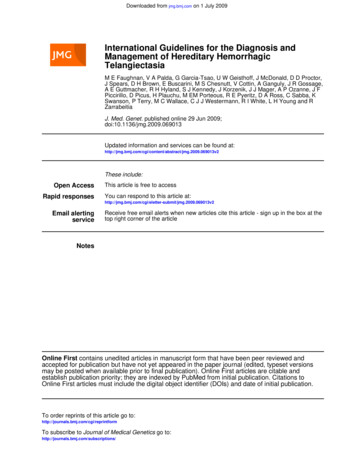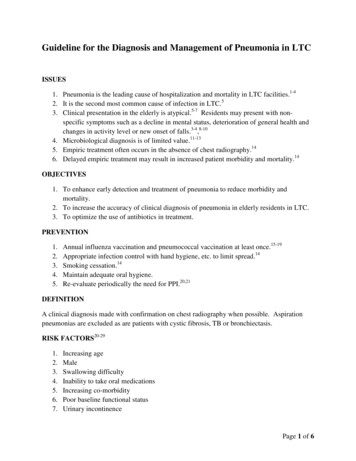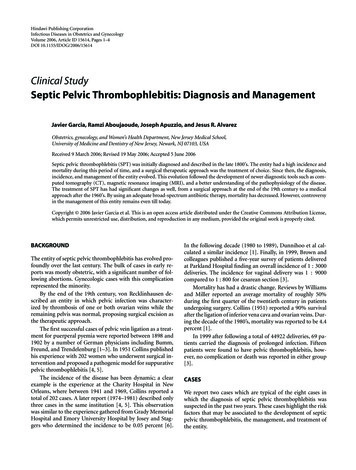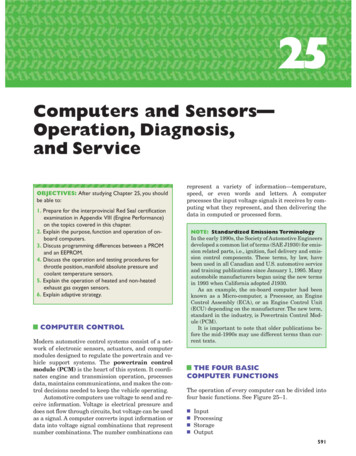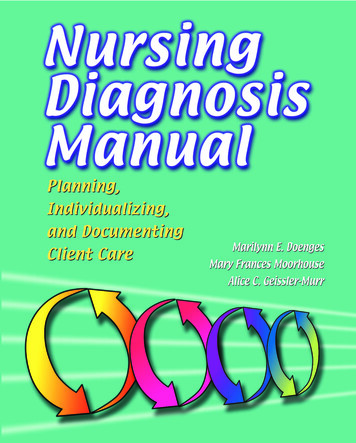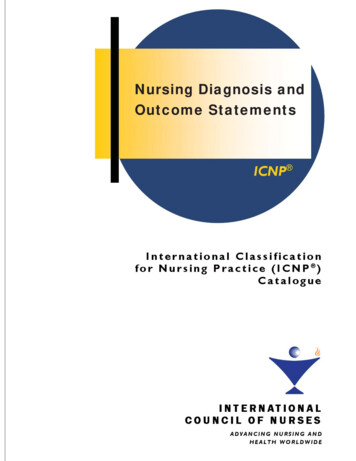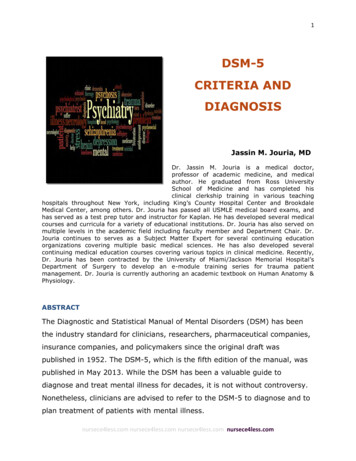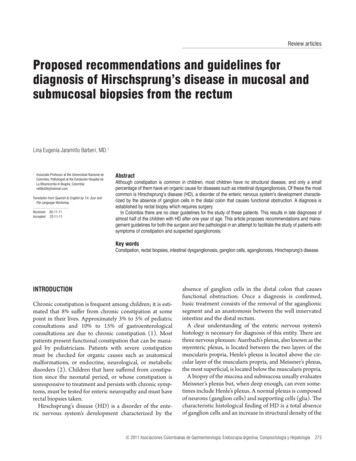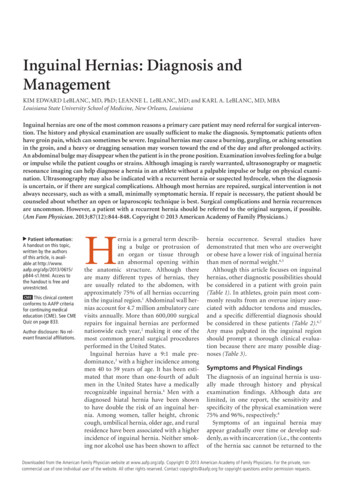
Transcription
Inguinal Hernias: Diagnosis andManagementKIM EDWARD LeBLANC, MD, PhD; LEANNE L. LeBLANC, MD; and KARL A. LeBLANC, MD, MBALouisiana State University School of Medicine, New Orleans, LouisianaInguinal hernias are one of the most common reasons a primary care patient may need referral for surgical intervention. The history and physical examination are usually sufficient to make the diagnosis. Symptomatic patients oftenhave groin pain, which can sometimes be severe. Inguinal hernias may cause a burning, gurgling, or aching sensationin the groin, and a heavy or dragging sensation may worsen toward the end of the day and after prolonged activity.An abdominal bulge may disappear when the patient is in the prone position. Examination involves feeling for a bulgeor impulse while the patient coughs or strains. Although imaging is rarely warranted, ultrasonography or magneticresonance imaging can help diagnose a hernia in an athlete without a palpable impulse or bulge on physical examination. Ultrasonography may also be indicated with a recurrent hernia or suspected hydrocele, when the diagnosisis uncertain, or if there are surgical complications. Although most hernias are repaired, surgical intervention is notalways necessary, such as with a small, minimally symptomatic hernia. If repair is necessary, the patient should becounseled about whether an open or laparoscopic technique is best. Surgical complications and hernia recurrencesare uncommon. However, a patient with a recurrent hernia should be referred to the original surgeon, if possible.(Am Fam Physician. 2013;87(12):844-848. Copyright 2013 American Academy of Family Physicians.) Patient information:A handout on this topic,written by the authorsof this article, is available at http://www.aafp.org/afp/2013/0615/p844-s1.html. Access tothe handout is free andunrestricted.CME This clinical contentconforms to AAFP criteriafor continuing medicaleducation (CME). See CMEQuiz on page 833.Author disclosure: No relevant financial affiliations.Hernia is a general term describing a bulge or protrusion ofan organ or tissue throughan abnormal opening withinthe anatomic structure. Although thereare many different types of hernias, theyare usually related to the abdomen, withapproximately 75% of all hernias occurringin the inguinal region.1 Abdominal wall hernias account for 4.7 million ambulatory carevisits annually. More than 600,000 surgicalrepairs for inguinal hernias are performednationwide each year,2 making it one of themost common general surgical proceduresperformed in the United States.Inguinal hernias have a 9:1 male predominance,3 with a higher incidence amongmen 40 to 59 years of age. It has been estimated that more than one-fourth of adultmen in the United States have a medicallyrecognizable inguinal hernia.4 Men with adiagnosed hiatal hernia have been shownto have double the risk of an inguinal hernia. Among women, taller height, chroniccough, umbilical hernia, older age, and ruralresidence have been associated with a higherincidence of inguinal hernia. Neither smoking nor alcohol use has been shown to affecthernia occurrence. Several studies havedemonstrated that men who are overweightor obese have a lower risk of inguinal herniathan men of normal weight.4,5Although this article focuses on inguinalhernias, other diagnostic possibilities shouldbe considered in a patient with groin pain(Table 1). In athletes, groin pain most commonly results from an overuse injury associated with adductor tendons and muscles,and a specific differential diagnosis shouldbe considered in these patients (Table 2).6,7Any mass palpated in the inguinal regionshould prompt a thorough clinical evaluation because there are many possible diagnoses (Table 3).Symptoms and Physical FindingsThe diagnosis of an inguinal hernia is usually made through history and physicalexamination findings. Although data arelimited, in one report, the sensitivity andspecificity of the physical examination were75% and 96%, respectively.8Symptoms of an inguinal hernia mayappear gradually over time or develop suddenly, as with incarceration (i.e., the contentsof the hernia sac cannot be returned to the June 15, 2013844 AmericanPhysicianwww.aafp.org/afp87, Number12 private,Downloadedfrom theFamilyAmericanFamily Physician website at www.aafp.org/afp.Copyright 2013 American Academy ofVolumeFamily Physicians.For thenoncommercial use of one individual user of the website. All other rights reserved. Contact copyrights@aafp.org for copyright questions and/or permission requests.
Inguinal Herniasabdominal cavity). Inguinal hernias may be asymptomatic and found incidentally on routine physical examination. Symptomatic patients often present with groinpain, which can be severe. Stretching or tearing of thetissue at and around the hernia defect can lead to a burning, gurgling, or aching sensation in the groin. This usually causes localized pain directly at the site of the hernia.Pain may worsen with Valsalva maneuvers. Patients mayTable 1. Differential Diagnosisof Groin PainAdhesionsAppendicitisAthletic pubalgia (sports hernia)Diverticulosis/diverticulitisHip pathology (osteoarthritis,avascular necrosis offemoral head)Inflammatory bowel diseaseLumbar disk diseaseMeralgia parestheticaPelvic pathology (osteitispubis, adductor strain)ProstatitisTesticular disordersUrinary tract infectionTable 2. Differential Diagnosis of Groin Painin AthletesDiagnosisClinical presentationAvulsion fracturesHistory of sudden or forceful musclecontraction, tenderness over bonyprominence, ecchymosesHistory of trauma or fall, suddenonsetHistory of sudden onset duringmuscle contractionAssociated paresthesias ornumbnessTenderness over symphysis pubisAssociated findings in these areasLigamentous sprainsMuscle strainsNerve entrapmentsyndromesOsteitis pubisReferred pain fromlumbar, hip, orsacroiliac areaSports herniaStress fracturesTendinopathiesHistory of high-intensity athleticactivity, typical symptoms ofhernia with no evidence onphysical examination, painwith forced adduction againstexaminer’s resistanceHistory of repetitive motion activityor overuse, tenderness over bonePain with motion and contraction ofspecific muscleInformation from references 6 and 7.June 15, 2013 Volume 87, Number 12experience a heavy or dragging sensation in the groin,especially toward the end of the day and after prolongedactivity.1 Activities that increase intra-abdominal pressure, such as coughing, lifting, or straining, cause moreabdominal contents to be pushed through the herniadefect. As this occurs, the bulge of the hernia graduallyincreases in size. If the patient indicates that this bulgedisappears while he or she is in the supine position, clinical suspicion of a hernia should be increased.Hernias may be easily diagnosed with an adequatephysical examination. The physical examination shouldbegin by carefully inspecting the femoral and inguinalareas for bulges while the patient is standing. Then, thepatient should be asked to strain down (i.e., Valsalvamaneuver) while the physician observes for bulges. Thismay be accomplished by using the right hand to examine the patient’s right side and the left hand to examine the patient’s left side. The physician invaginates theloose skin of the scrotum with the indexChronic pain is the mostfinger on the ipsilatcommon long-termeral side of the patient,issue after hernia repair.starting at a point lowenough on the scrotum to reach as far as the internal inguinal ring. Startingon the scrotum, the examining finger follows the spermatic cord upward above the inguinal ligament to thetriangular, slit-like opening of the external inguinal ring.The external inguinal ring is medial to and just belowthe pubic tubercle. The inguinal canal is gently followedlaterally in its oblique course. While the examining finger is in the canal next to the internal inguinal ring, thepatient strains down or coughs as the physician feels forany palpable herniation.9 The diagnosis of an inguinalhernia is confirmed if an “impulse” or bulge is felt.If no bulge is detected with a Valsalva maneuver, ahernia is unlikely. However, athletic pubalgia (sportshernia) may be considered in athletes with groin painand no bulge. A sports hernia is not a true hernia, butrather a tearing of tissue fibers. This typically occurs inpatients with a history of high-intensity athletic activity.Although these patients have typical hernia symptoms,there is no evidence on physical examination. Furtherfollow-up and reexamination are needed to diagnose asports hernia. Pain along the symphysis pubis suggestsosteitis pubis, whereas pain along the adductor tendonssuggests adductor tendinopathy.It is more challenging to diagnose a hernia in femalepatients. Direct palpation with an open hand overthe groin area might detect the impulse of a herniaduring a Valsalva maneuver. However, further workupwww.aafp.org/afp American Family Physician 845
Inguinal Herniaswith diagnostic testing or referral to a surgeon is often indicated. Rarely, diagnosticlaparoscopy is necessary.Incarceration may be managed in theoffice setting if there is no associated pain.The standard of care is to place the patientin the Trendelenburg position while holdinggentle pressure on the area for up to 15 minutes. If acute onset of groin pain occurs, thehernia may have become strangulated (i.e.,the blood supply to the entrapped contentsis compromised). Strangulation should besuspected in the presence of tenderness, redness, nausea, and vomiting and is a surgicalemergency.10Table 3. Differential Diagnosis of Groin and ScrotalMassesDiagnosisClinical presentationEctopic testisEpididymitisAbsence of a testis in the scrotumSevere pain surrounding the testis, tenderness,fever, chillsBilateral, firm, tender nodes; feverFemoral adenitis/adenopathyFemoral arterialaneurysmFemoral herniaHematomaOlder patient, pulsatile mass, no systemic symptomsMore common in women, often incarcerated, bowelobstructionAssociated trauma, ecchymoses, tenderness, nochange with Valsalva maneuverDraining abscesses in intertriginous skin of the groinMass in the scrotum or inguinal canal thattransilluminatesTenderness, redness possible, often bilateral,systemic symptomsBulge or impulse detected in inguinal canal withValsalva maneuver or coughingSoft, asymptomatic mass; does not change in sizeFirm, tender mass; may increase in size;organomegaly; systemic symptomsFirm, tender mass; may be enlarging; systemicsymptoms or weight lossFlank or back pain, fever, inguinal mass, limp,weight lossSoft mass, nontender, more superficial, no changewith Valsalva maneuverAcute onset of pain with a high-riding testis,swelling, very tenderUsually asymptomatic or dull ache, unilateral “bagof worms” in scrotumHidradenitisImagingHydroceleAlthough imaging is rarely needed to diagnose a hernia, it may be useful in certainInguinal adenitis/clinical situations (e.g., suspected sports heradenopathynia; recurrent hernia or possible hydrocele;Inguinal herniauncertain diagnosis; surgical complications,especially chronic pain).8 The clinical use ofLipomaultrasonography has shown promise in theseLymphomasituations.11,12 The sensitivity of ultrasonogMetastaticraphy for the detection of groin hernias isneoplasiagreater than 90%, and the specificity is 82%8,13Psoasabscessto 86%.Use of higher resolution axial computedSebaceous cysttomography in the diagnosis of inguinal14hernia is being investigated. Magnetic resTesticular torsiononance imaging may be useful in differentiating inguinal and femoral hernias with aVaricocelehigh sensitivity and specificity (greater than95%).8 The use of magnetic resonanceimaging is helpful in the diagnosis of athletic pubalgia or sports hernias, which may occur at and strangulation, and to seek prompt evaluation if theseany age with potentially more than one cause. The occur.16,17 Patients with symptomatic, large, or recurrentphysician may consider magnetic resonance imaging hernias should be referred for repair, generally withinin the workup of patients with activity-related groin one month of detection.18 Hernia repair almost alwayspain when no inguinal hernia can be identified on involves some type of prosthetic material (i.e., mesh),physical examination.15with the possible exception of women of childbearing agebecause stretching of tissues during pregnancy may resultSurgical Managementin a recurrent hernia. The choice of mesh material used inIn the past, surgical repair was recommended for all the repair is based on the surgeon’s preference.inguinal hernias because of the risk of complications suchThe choice of open vs. laparoscopic repair depends onas incarceration or strangulation. However, recent stud- surgeon preference, but only about 10 percent of inguiies have proved that small, minimally symptomatic, first nal hernia repairs in the United States are performedoccurrence hernias do not necessarily require repair, and via a laparoscopic technique.19 Open repair may bethese patients can be followed expectantly. However, they particularly beneficial in older, less healthy patients.20should be counseled on the symptoms of incarceration Laparoscopic repair is usually reserved for recurrent846 American Family Physicianwww.aafp.org/afpVolume 87, Number 12 June 15, 2013
Inguinal HerniasSORT: KEY RECOMMENDATIONS FOR PRACTICEClinical recommendationAlthough imaging techniques such as ultrasonography, computed tomography, and magneticresonance imaging are rarely needed to diagnose inguinal hernias, they may be useful in certainclinical situations.Ultrasonography has good sensitivity and specificity for the detection of groin hernias.Small, minimally symptomatic, first hernias do not necessarily require repair, and these patientsmay be followed expectantly. They should be counseled on symptoms of incarceration orstrangulation, and to seek prompt evaluation if these occur.Patients with symptomatic, large, or recurrent inguinal hernias should be referred for repair,genera
15.06.2013 · nias account for 4.7 million ambulatory care visits annually. More than 600,000 surgical repairs for inguinal hernias are performed . recognizable inguinal hernia.4 Men
